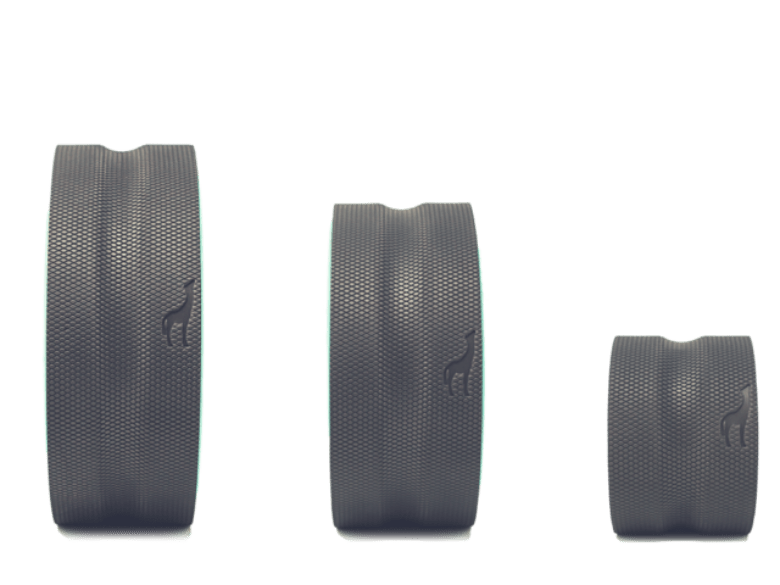At the onset of my struggle with back pain, I did not know how counterproductive it would be to relax on the couch or bed, waiting for the pain to resolve.
When my back pain progressed, I consulted a doctor friend who proposed I get the Chirp+ Wheel to use at home. I now use it daily, and the results are what I had hoped.
I will discuss using the wheel over a physical therapist.
What You Need to Know About Back Pain
When you experience back pain, it usually is pain or physical discomfort at any point along your spine.
It can occur in four different regions along your spinal cord, from the neck or cervical region; your upper back or thoracic region; your lower back, or the lumbar region; and your tailbone, also known as the sacral region.
It can range from mild pain to severe pain. At all times, any form of pain in your back requires immediate attention to alleviate and prevent further damage.
The World Health Organization says back pain forces US citizens, altogether, to miss over 140 million workdays.
There are various types of back pain, as I will briefly describe below.
Types of Back Pain
80% of people around the world suffer from back pain at one point in life. For most, it is easily resolved, while for others, it becomes a life-long condition.
Back pain is classified as either acute or chronic.
Acute Back Pain
Acute back pain occurs for brief periods, in most cases, less than a month. This type is familiar with many people, as it can happen and resolve on its own without complicated treatment plans.
It is the kind I experienced, and I comfortably used the Chirp Wheel+ to alleviate pain.
For many people, this kind of back pain stems from activities done daily. Acute back pain can occur from workouts, slouching, heavy lifting, sedentary living, and other causes.
Acute back pain results, in most people, from strains, injury, herniated discs, trauma, stress or depression, muscle spasms, or constipation, among other causes.
Chronic Back Pain

The other type of back pain, chronic back pain, is a more severe condition. It usually lasts a few months, and can continuously occur all your life.
Chronic pain can be caused by the same reasons as acute pain, and it can also occur because of more severe conditions.
These include:
- severe trauma to the back and spine
- cancers
- osteomyelitis
- severe neurological problems
- arthritis
- epidural abscess between your spine and vertebrae
- among other causes.
Please note, even when you know the type and cause of your back pain, you need to take immediate action if the pain lasts longer than three days. Consulting a doctor on the best treatment can help you prevent further injury or severe pain.
A doctor will help you diagnose the pain, track the respective region it affects, and determine the best way to treat it. They can advocate for necessary physical therapy, and in severe cases, advanced treatment such as surgery and more.
Diagnosing Back Pain
Back pain presents as a condition that is very complex and difficult to diagnose or even treat. It is common for back pain to occur and then disappear before you seek treatment, and then reappear again when you have slightly moved on.
When you are trying to diagnose your back pain, visiting a doctor is significant. To them, you will describe your back pain, and they will determine the type.
Some people prefer journaling their pain experiences days before visiting the doctor. Doing this is beneficial when you are describing your pain.
Even when you are not visiting the doctor, it is vital to note how your pain occurs. These are details like where, for how long, and when. This information will help you treat the condition effectively and with ease.
These details are how you can describe your back pain:
- Describe the intensity of the pain. How bad is the pain? You can rate it from one to 10, with ten being the most painful.
- Describe the pain itself. What does it feel like? Is it a dull or sharp pain? Is it constant? You can use many descriptive words that can help you describe the pain; these include burning, flickering, sharp, rhythmic, and many more.
- Describe the location. Where does the pain occur? Does it change over time? This information is vital in diagnosing back pain. You need to know the trigger points and how the pain transfers to other areas in some cases.
- Describe the timing of your pain. When does it occur? Does it occur at a particular time of the day or after a particular activity? Understanding this pattern will help you diagnose and also devise a treatment plan, or rather, the best time to undertake treatment.
- Describe how the pain affects you. When the pain occurs, either intermittently or constantly, how does it affect your daily life? Are you able to function, during the pain, as you normally do without?
Please note that when diagnosing back pain, you need to be brutally honest about your psychological health. If consulting a doctor, they will ask if you have depression, using drugs, and other guiding questions.
When we are emotionally or mentally deprived, we may tend to use pain as a comforting mechanism. For this reason, the American College of Physicians recommends cognitive behavior therapy for many patients with back pain issues.
When you can efficiently describe your back pain, you can quickly get a diagnosis that will guide you in adopting the best treatment plan.
Treating Back Pain
Once you know the type of back pain, the location of the pain, and all factors related to the discomfort, you need to devise a plan to prevent, alleviate, and treat it.
We strongly recommend you discuss the following options with your doctor. Your back is critical and delicate, so you should be very cautious when performing any type of therapy.
To manage your back pain, you can perform your therapy at home or opt for a physical therapist.
When to Use the Chirp Wheel+
I will discuss ways you can use the Chirp Wheel+ at home, and why you can use it more than a physical therapist.
The use of this wheel, as discussed herein, may only apply in cases of acute back pain. If you want to use it for chronic back pain, I strongly recommend talking about its use with your doctor.
In strict accordance with your doctor’s advice, you can opt to control back pain on your own in your home. In this case, you know what is causing the pain and what you can do to stop and prevent it.
The pain, mostly caused by daily chores, poor posture, workout exercises, or lack thereof, can be managed and prevented at home. You can adopt necessary and targeted activities and practices to avoid pain and improve your quality of life.
When I had back pain, I worked on my computer for at least seven hours a day, which taught me how to slouch. The effect was a nasty case of lower back pain. I consulted a doctor who recommended the Chirp Wheel+ to alleviate the back pain and prevent it from reoccurring in the future.
The following is detailed information on this back roller and how you can alleviate and prevent acute back pain.
The Chirp Wheel+
This Chirp Wheel+ is a piece of workout equipment you can use to target back pain. It is built to massage and stretch your back muscles, and to help you learn a new exercise routine that is essential for your back.
In its design and performance, the wheel will alleviate pain in all four regions of your back, from the neck down to the tailbone.
Design
The Chirp Wheel+ is made of durable and rigid hard plastic, which is covered in a comfortable 20mm foam pad.
It stands out from other yoga wheels in design also. It features a spinal canal in the middle that ensures your spine is protected while you roll on it.
The Chirp Wheel may appear and feel soft to the touch, but it is made firm with an injection molded rigid core that can withstand up to 500lbs.
Sizes
This wheel comes in three sizes. They are:
- 6-Inch wheel. This wheel is the smallest in the pack. It offers the deepest massage pressure that targets knots and tight muscles in your neck, back, and even legs.
You can use the wheel on your chair when working on your computer to observe an ergonomic sitting position. - 10-Inch wheel. The second-largest wheel is designed to offer medium pressure to a massage to your back and hips. It will release tension in your muscles. You can use the wheel on the floor or against the wall.
- 12-Inch wheel. This wheel is the largest, and it offers gentle pressure to a massage. It is easy to use on the entire spine.
This stretching wheel will massage your upper and lower back. It stretches all muscles along your spine to offer you the best non-invasive pain relief.
The Chirp Wheel+ vs Physical Therapists For Back Pain
In the instance your back pain is easily manageable from home, and after you have consulted your doctor, you can use the Chirp Wheel Plus in place of a physical therapist.
A physical therapist will cost you money on each visit, and the results of the therapy are very similar to those of the wheel.
Here is how you can use the Chirp Wheel+ to enjoy the same benefits as you would on an appointment with a physical therapist.
How to Use The Wheel For Physical Therapy
This wheel is extremely versatile in use, and you can choose to have it as your primary method of physical therapy.
As with visiting a physical therapist, this wheel will realign and improve all impairments in your back along the spine and pelvis. It will help you relieve pain and therefore improve your productivity and mood.
When it comes to using the Chirp Wheel+ for physical therapy, there are essential aspects it ensures you enjoy just as much as you would from a therapist. These are comfort and safety. It provides this through its design, ease of use, and strength.
You can use the Chirp Wheel+ to relieve and prevent back pain through many physical exercises. The most important use of this back roller, however, is its massaging and stretching effects which are vital in the management of back pain.
When using this yoga wheel, it protects your spine from excess pressure when rolling, and offers a four-way massage, horizontally and laterally.
In many cases of back pain, pressure along the spine is usually the cause. Using the Chirp Wheel+ prevents this through Chirp’s patented spinal canal design.
People dealing with back pain experience nasty side effects of the condition, such as headaches and other forms of tension. With the Ultimate Back Pain Bundle, you get the smallest wheel to massage the deep tissues in your neck to alleviate even headaches.
Instead of complicated forms of therapy to improve mobility, using this wheel can guarantee you better results in very little time. The 10-inch and 12-inch wheels will help you stretch and open up your back muscles that might be causing you problems.
The best thing about the Chirp wheels is that the larger you choose, the gentler the massage and overall therapy is, thereby eliminating the risk of overstretching and straining your back muscles.
7 Reasons a Chirp Wheel+ is Better For Back Pain
These are the reasons why the wheel may be a better option for therapy.
- The wheel is affordable.
- The wheel is portable. Using the wheel for back therapy means you can use them in many environments. They are also lightweight so that you can travel with them.
- You can use the wheel daily.
- Using the wheel has little to no side effects.
- It is easy to use, to massage your whole back, prevents unnecessary pressure to your spine and vertebrae, and stretches your inner muscles.
- It will improve your flexibility and encourage a healthier and more active lifestyle.
- It is a form of therapy that only targets your problem area.
Conclusion
Dealing with any form of back pain is very unfortunate. It is a condition that hinders productivity and can lead to even more serious conditions such as depression.
The Chirp Wheel+ is a very versatile piece of equipment you can use for back pain therapy. It can help you reduce pain and even prevent it in the future.
Cheaper than booking appointments with a physical therapist, this wheel is easy to use once you master the skill of rolling and stretching.
It compares, in performance, to the benefits of professional physical therapy, with the added advantage of you doing it yourself and at any time you desire or need.
Consult your doctor before using the wheel, and start with simple stretches once you begin use.
Suppose the wheel makes you feel uncomfortable or increases pain rather than reduce it. In that case, we recommend you immediately stop use and consult your doctor or another professional who can guide you on the best exercises to perform with the wheel.







